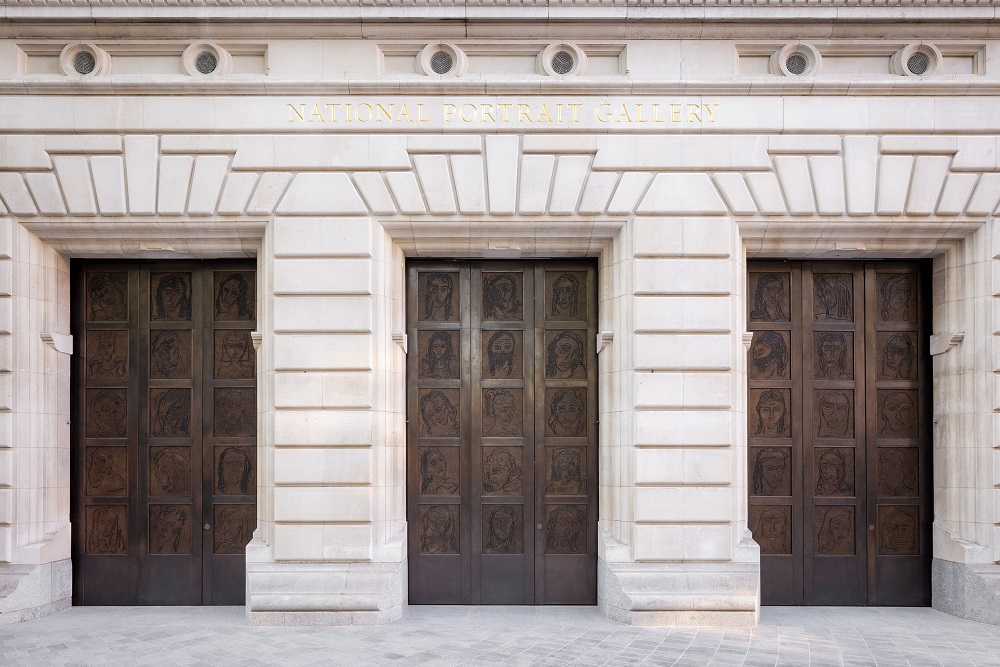Forty-five portraits that “represent every woman” cover the three doors that now form the entrance to the National Portrait Gallery. Hand drawn by Tracey Emin and cast in bronze, The Doors (2023) counterbalance the sculpted roundels carved into the Gallery’s façade, depicting prominent male figures from history.
Today, the National Portrait Gallery announces a significant new commission ahead of reopening later this week on Thursday, 22 June – The Doors (2023) by Tracey Emin CBE RA. It consists of 45 individual panels across the three new doors of the National Portrait Gallery; the significant new public artwork advances the Gallery’s commitment to working with the greatest living artists and increasing the representation of women within its Collection.

Central to the Gallery’s new forecourt, Ross Place, Tracey Emin’s low-relief bronze panels celebrate women from different walks of life, known and unknown. Mothers, daughters, sisters and friends are portraits of every woman. Central to the vision of the new National Portrait Gallery, the panels are the artist’s contemporary response to the under-representation of women in historical art collections. The Doors (2023) now counterbalance the Portland stone busts carved into the building’s façade, which depict 18 male biographical writers, historians and eminent artists from history, including Horace Walpole, Hans Holbein the Younger, Sir Anthony van Dyck and Sir Joshua Reynolds and give this imposing public space a very human touch.
Reworking the surface of the clay before casting the panels in bronze at an East London foundry, the artist’s finger and thumbprints remain visible in metal, revealing the making process. Originally painted in acrylic on paper, Emin’s drawings were then meticulously transcribed onto the bronze panels.
“Women in history are greatly underrepresented. I didn’t want to depict specific or identifiable figures. I felt like the doors of the National Portrait Gallery should represent every woman, every age and every culture throughout time. I used myself as a mental template, but the result is many different women, some that exist in my mind and some that perhaps exist in reality here and now, as well as from the past. And with all terms of art, it’s up to the viewer to discern what they feel and what they see or who they see, for that matter. I want people to stand before the doors and say, ‘She looks like my mother; she looks like my best friend, my daughter’. People might also relate and see an element of pain or heartbreak in the images.”

“In 2020, Jamie Fobert and I talked about how the new National Portrait Gallery doors needed a human touch to balance the imposing façade with its roundels of eighteen men from British history. Tracey Emin came immediately to mind as one of the greatest artists working today and was the natural choice for this prominent commission, given her mastery of drawing and bronze sculpture, here brought together innovatively and strikingly. She has created something perfect for its context, that is moving yet monumental and that we hope everyone who walks through our doors will enjoy and relate to.”
More than 50 works acquired and commissioned during the Gallery’s closure will be displayed when the National Portrait Gallery reopens on 22 June, substantially enhancing the representation of women across its Collection. Necessary historic loans and acquisitions have enriched our galleries, such as the earliest large-scale portrait of an English woman and one of the first large-scale portraits of a single individual in the UK, Lady Margaret Beaufort (circa 1510), and the self-portrait of the Victorian miniaturist Sarah Biffin (circa 1820), who was born without arms and legs. Since the closure, 36% of portraits on display across the Gallery will be of women, rising to 48% in post-1900 galleries.
Founded in 1856, the National Portrait Gallery tells the story of Britain through portraits, using art to bring history to life and explore living today. From global icons to unsung heroes, our Collection is filled with the stories that have shaped and continue to shape a nation. We celebrate the power of portraiture and offer encounters with some of the world’s greatest and most exciting new artists, promoting engagement with portraiture in all media to a wide-ranging public by conserving, growing and sharing the world’s most extensive collection of portraits.
The Gallery in St Martin’s Place, London, has been closed until 22 June 2023. Essential building works take place on the Inspiring People redevelopment project, which will transform the Gallery, including a complete refurbishment and a new learning centre. During the closure period, we have continued to share our Collection digitally and through a series of nationwide partnerships and collaborations.
Collaborators on the Inspiring People project include Jamie Fobert Architects; conservation architects, Purcell; structural engineers, Price & Myers; services engineers, Max Fordham; project manager, Gardiner & Theobald; main contractor, Gilbert-Ash; and interpretation designers, Nissen Richards Studio.

